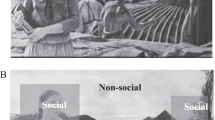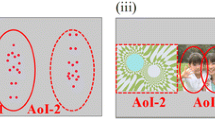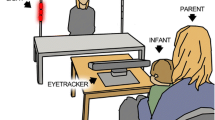Abstract
Eye-tracking is often used to study attention in children with autism spectrum disorder (ASD). Previous research has identified multiple atypical patterns of attention in children with ASD based on areas-of-interest analysis. Fewer studies have investigated gaze path, a measure which is dependent on the dynamic content of the stimulus presented. Here, rather than looking at proportions of looking time to areas of interest, we calculated mean fixations frame-by-frame in a group of typically developing children (36 to 72 months) and determined the distance from those typical fixations for 155 children with ASD (27–95 months). Findings revealed that distance from the typical scan path among the children with ASD was associated with lower communication abilities and greater ASD symptomatology.





Similar content being viewed by others
References
Aman, M. G., Singh, N. N., Stewart, A. W., & Field, C. J. (1985). The aberrant behavior checklist: A behavior rating scale for the assessment of treatment effects. American Journal Of Mental Deficiency, 89, 485.
American Psychiatric Association. (2013). Diagnostic and statistical manual of mental disorders (5th ed.). Arlington, VA: American Psychiatric Publishing.
Arunachalam, S., & Luyster, R. J. (2015). The integrity of lexical acquisition mechanisms in autism spectrum disorders: A research review. Autism Research, 9, 810.
Charman, T. (2003). Why is joint attention a pivotal skill in autism? Philosophical Transactions of The Royal Society of London Series B Biological Sciences, 358(1430), 315–324. https://doi.org/10.1098/Rstb.2002.1199.
Chawarska, K., Macari, S., & Shic, F. (2012). Context modulates attention to social scenes in toddlers with autism. Journal Of Child Psychology And Psychiatry, 53(8), 903–913. https://doi.org/10.1111/J.1469-7610.2012.02538.X.
Chawarska, K., Macari, S., & Shic, F. (2013). Decreased spontaneous attention to social scenes in 6-month-old infants later diagnosed with autism spectrum disorders. Biological Psychiatry, 74(3), 195–203. https://doi.org/10.1016/J.Biopsych.2012.11.022.
Chawarska, K., Ye, S., Shic, F., & Chen, L. (2015). Multilevel differences in spontaneous social attention in toddlers with autism spectrum disorder. Child Development, 87, 543.
Chevallier, C., Parish-Morris, J., Mcvey, A., Rump, K. M., Sasson, N. J., Herrington, J. D., & Schultz, R. T. (2015). Measuring social attention and motivation in autism spectrum disorder using eye-tracking: Stimulus type matters. Autism Research, 8(5), 620–628.
Chita-Tegmark, M. (2016). Social attention in asd: A review and meta-analysis of eye-tracking studies. Research in Developmental Disabilities, 48, 79–93.
Cilia, F., Aubry, A., Le Driant, B., Bourdin, B., & Vandromme, L. (2019). Visual exploration of dynamic or static joint attention bids in children with autism syndrome disorder. Frontiers in Psychology, 10, 2187.
Cohen, I. L., Schmidt-Lackner, S., Romanczyk, R., & Sudhalter, V. (2003). The pdd behavior inventory: A rating scale for assessing response to intervention in children with pervasive developmental disorder. Journal of Autism and Developmental Disorders, 33(1), 31–45.
Constantino, J. N., Kennon-Mcgill, S., Weichselbaum, C., Marrus, N., Haider, A., Glowinski, A. L., et al. (2017). Infant viewing of social scenes is under genetic control and is atypical in autism. Nature, 547(7663), 340.
Dawson, G., Munson, J., Estes, A., Osterling, J., Mcpartland, J., Toth, K., et al. (2002). Neurocognitive function and joint attention ability in young children with autism spectrum disorder versus developmental delay. Child Development, 73(2), 345–358. https://doi.org/10.1111/1467-8624.00411.
Dawson, G., Toth, K., Abbott, R., Osterling, J., Munson, J., Estes, A., & Liaw, J. (2004). Early social attention impairments in autism: Social orienting, joint attention, and attention to distress. Developmental Psychology, 40(2), 271–283. https://doi.org/10.1037/0012-1649.40.2.271.
Elliott, C. (2007). Differential ability scales (Vol. 22, pp. 128–132). San Antonio, TX: Harcourt Assessment.
Elsabbagh, M., Bedford, R., Senju, A., Charman, T., Pickles, A., Johnson, M. H., & Team B. (2014). What you see is what you get: Contextual modulation of face scanning in typical and atypical development. Social Cognitive and Affective Neuroscience, 9(4), 538–543.
Falck-Ytter, T., Bölte, S., & Gredebäck, G. (2013). Eye tracking in early autism research. Journal of Neurodevelopmental Disorders, 5(1), 28.
Falck-Ytter, T., Von Hofsten, C., Gillberg, C., & Fernell, E. (2013). Visualization and analysis of eye movement data from children with typical and atypical development. Journal of Autism and Developmental Disorders, 43(10), 2249–2258.
Goodman, R. (1997). The strengths and difficulties questionnaire: A research note. Journal of Child Psychology and Psychiatry, 38(5), 581–586.
Goodman, R. (2001). Psychometric properties of the strengths and difficulties questionnaire. Journal of The American Academy of Child & Adolescent Psychiatry, 40(11), 1337–1345.
Goodman, R., Ford, T., Simmons, H., Gatward, R., & Meltzer, H. (2000). Using the strengths and difficulties questionnaire (Sdq) to screen for child psychiatric disorders in a community sample. The British Journal of Psychiatry, 177(6), 534–539.
Guillon, Q., Hadjikhani, N., Baduel, S., & Rogé, B. (2014). Visual social attention in autism spectrum disorder: Insights from eye tracking studies. Neuroscience & Biobehavioral Reviews, 42, 279–297.
Habayeb, S., Tsang, T., Saulnier, C., Klaiman, C., Jones, W., Klin, A., & Edwards, L. A. (2020). Visual traces of language acquisition in toddlers with autism spectrum disorder during the second year of life. Journal of Autism and Developmental Disorders. https://doi.org/10.1007/s10803-020-04730-x.
Hanley, M., Mcphillips, M., Mulhern, G., & Riby, D. M. (2013). Spontaneous attention to faces in asperger syndrome using ecologically valid static stimuli. Autism, 17(6), 754–761.
Jones, W., Carr, K., & Klin, A. (2008). Absence of preferential looking to the eyes of approaching adults predicts level of social disability in 2-year-old toddlers with autism spectrum disorder. Archives of General Psychiatry, 65(8), 946–954. https://doi.org/10.1001/Archpsyc.65.8.946.
Kennedy, D. P., D’onofrio, B. M., Quinn, P. D., Bölte, S., Lichtenstein, P., & Falck-Ytter, T. (2017). Genetic influence on eye movements to complex scenes at short timescales. Current Biology, 27(22), 3554–3560.
Klin, A., Jones, W., Schultz, R., Volkmar, F., & Cohen, D. (2002a). Defining and quantifying the social phenotype in autism. American Journal of Psychiatry, 159(6), 895–908.
Klin, A., Jones, W., Schultz, R., Volkmar, F., & Cohen, D. (2002b). Visual fixation patterns during viewing of naturalistic social situations as predictors of social competence in individuals with autism. Archives of General Psychiatry, 59(9), 809–816. https://doi.org/10.1001/Archpsyc.59.9.809.
Klin, A., Lin, D. J., Gorrindo, P., Ramsay, G., & Jones, W. (2009). Two-year-olds with autism orient to non-social contingencies rather than biological motion. Nature, 459(7244), 257–261.
Le Couteur, A., Lord, C., & Rutter, M. (2003). The autism diagnostic interview-revised (Adi-R) (pp. 659–685). Los Angeles: Western Psychological Services.
Lönnqvist, L., Loukusa, S., Hurtig, T., Mäkinen, L., Siipo, A., Väyrynen, E., et al. (2017). How young adults with autism spectrum disorder watch and interpret pragmatically complex scenes. The Quarterly Journal of Experimental Psychology, 70(11), 2331–2346.
Lord, C., Rutter, M., Dilavore, P., Risi, S., Gotham, K., & Bishop, S. (2012). Autism diagnostic observation schedule–2nd edition (Ados-2). Los Angeles: Western Psychological Corporation.
Mastergeorge, A. M., Kahathuduwa, C., & Blume, J. (2020). Eye-tracking in infants and young children at risk for autism spectrum disorder: A systematic review of visual stimuli in experimental paradigms. Journal of Autism and Developmental Disorders. https://doi.org/10.1007/s10803-020-04731-w.
Mullen, E. M. (1995). Mullen scales of early learning. Circle Pines, MN: American Guidance Service.
Mundy, P., Sigman, M., & Kasari, C. (1990). A longitudinal study of joint attention and language development in autistic children. Journal of Autism and Developmental Disorders, 20(1), 115–128.
Murias, M., Major, S., Davlantis, K., Franz, L., Harris, A., Rardin, B., et al. (2018). Validation of eye-tracking measures of social attention as a potential biomarker for autism clinical trials. Autism Research, 11(1), 166–174.
Nakano, T., Tanaka, K., Endo, Y., Yamane, Y., Yamamoto, T., Nakano, Y., et al. (2010). Atypical gaze patterns in children and adults with autism spectrum disorders dissociated from developmental changes in gaze behaviour. Proceedings of The Royal Society B, 277(1696), 2935–2943. https://doi.org/10.1098/Rspb.2010.0587.
Pelphrey, K. A., Sasson, N. J., Reznick, J. S., Paul, G., Goldman, B. D., & Piven, J. (2002). Visual scanning of faces in autism. Journal of Autism & Developmental Disorders, 32(4), 249–261.
Rice, K., Moriuchi, J. M., Jones, W., & Klin, A. (2012). Parsing heterogeneity in autism spectrum disorders: Visual scanning of dynamic social scenes in school-aged children. Journal of The American Academy of Child & Adolescent Psychiatry, 51(3), 238–248.
Sargezeh, B. A., Ayatollahi, A., & Daliri, M. R. (2019). Investigation of eye movement pattern parameters of individuals with different fluid intelligence. Experimental Brain Research, 237(1), 15–28.
Sasson, N. J., Turner-Brown, L. M., Holtzclaw, T. N., Lam, K. S. L., & Bodfish, J. W. (2008). Children with autism demonstrate circumscribed attention during passive viewing of complex social and nonsocial picture arrays. Autism Research, 1(1), 31–42. https://doi.org/10.1002/Aur.4.
Schomaker, J., Walper, D., Wittmann, B. C., & Einhäuser, W. (2017). Attention in natural scenes: Affective-motivational factors guide gaze independently of visual salience. Vision Research, 133, 161–175.
Shic, F., Bradshaw, J., Klin, A., Scassellati, B., & Chawarska, K. (2011). Limited activity monitoring in toddlers with autism spectrum disorder. Brain Research, 1380, 246–254.
Shic, F., Macari, S., & Chawarska, K. (2013). Speech disturbs face scanning in 6-month-old infants who develop autism spectrum disorder. Biological Psychiatry, 75, 231.
Sinha, P., Kjelgaard, M. M., Gandhi, T. K., Tsourides, K., Cardinaux, A. L., Pantazis, D., et al. (2014). Autism as a disorder of prediction. Proceedings of The National Academy of Sciences, 111(42), 15220–15225.
Sparrow, S. S. (2011). Vineland adaptive behavior scales. In J. Kreutzer, J. Deluca, & B. Caplan (Eds.), Encyclopedia of clinical neuropsychology (pp. 2618–2621). New York: Springer.
Sparrow, S. S., Cicchetti, D. V., & Saulnier, C. A. (2016). Vineland-3: Vineland adaptive behavior scales. San Antonio: Pearson.
Speer, L. L., Cook, A. E., Mcmahon, W. M., & Clark, E. (2007). Face processing in children with autism: Effects of stimulus contents and type. Autism, 11(3), 265–277. https://doi.org/10.1177/1362361307076925.
Sullivan, M., Finelli, J., Marvin, A., Garrett-Mayer, E., Bauman, M., & Landa, R. (2007). Response to joint attention in toddlers at risk for autism spectrum disorder: A prospective study. Journal of Autism and Developmental Disorders, 37(1), 37–48.
Tenenbaum, E. J., Amso, D., Abar, B., & Sheinkopf, S. J. (2014). Attention and word learning in autistic, language delayed and typically developing children. Frontiers in Psychology, 5, 490.
Tenenbaum, E. J., Amso, D., Righi, G., & Sheinkopf, S. J. (2017). Attempting to “increase intake from the input”: Attention and word learning in children with autism. Journal of Autism and Developmental Disorders, 47(6), 1791–1805.
Tenenbaum, E. J., Sobel, D. M., Sheinkopf, S. J., Malle, B. F., & Morgan, J. L. (2014). Attention to the mouth and gaze following in infancy predict language development. Journal of Child Language, 42, 1173.
Wagner, J. B., Hirsch, S. B., Vogel-Farley, V. K., Redcay, E., & Nelson, C. A. (2013). Eye-tracking, autonomic, and electrophysiological correlates of emotional face processing in adolescents with autism spectrum disorder. Journal of Autism and Developmental Disorders, 43(1), 188–199.
Wakabayashi, A., Baron-Cohen, S., Wheelwright, S., & Tojo, Y. (2006). The autism-spectrum quotient (Aq) in Japan: A cross-cultural comparison. Journal of Autism and Developmental Disorders, 36(2), 263–270.
Wang, Q., Campbell, D. J., Macari, S. L., Chawarska, K., & Shic, F. (2018). Operationalizing atypical gaze in toddlers with autism spectrum disorders: A cohesion-based approach. Molecular Autism, 9(1), 25.
Wechsler, D. (2002). Wechsler preschool and primary scale of intelligence (Wppsi-Iii) (3rd ed.). San Antonio: Pearson.
Young, G. S., Merin, N., Rogers, S. J., & Ozonoff, S. (2009). Gaze behavior and affect at 6 months: Predicting clinical outcomes and language development in typically developing infants and infants at risk for autism. Developmental Science, 12(5), 798–814.
Acknowledgements
This research was supported by grants from NICHD P50HD093074, the Marcus Foundation, and a NARSAD Young Investigator Grant from the Brain & Behavior Research Foundation (#23807). We thank Fred Shic, PhD for his input on this work.
Author information
Authors and Affiliations
Corresponding author
Ethics declarations
Conflict of interest
Dr. Dawson is on the Scientific Advisory Boards of Janssen Research and Development, Akili, Inc, LabCorp, Inc, Roche Pharmaceutical Company, and Tris Pharma, and is a consultant to Apple, Gerson Lehrman Group, Guidepoint, Inc, Axial Ventures, Teva Pharmaceutical, and is CEO of DASIO, LLC. Dr. Dawson has received book royalties from Guilford Press, Oxford University Press, Springer Nature Press. In addition, Dr. Dawson has the following patent applications: 1802952, 1802942, 15141391, and 16493754. Dawson and Carpenter helped develop technology for early screening for ASD. The technology has been licensed and Dawson, Carpenter, and Duke University have benefited financially. Dr. Howard reports personal fees from Roche.
Additional information
Publisher's Note
Springer Nature remains neutral with regard to jurisdictional claims in published maps and institutional affiliations.
Electronic supplementary material
Below is the link to the electronic supplementary material.
Electronic supplementary material 1 (AVI 18278 kb)
Video shows the full stimulus overlain with the mean fixations frame-by-frame. Blue indicates the mean for the TD group. Red indicates mean fixation for the ASD participants. Boxes show standard deviation for X and Y axes.
Electronic supplementary material 2 (MP4 14480 kb)
Rights and permissions
About this article
Cite this article
Tenenbaum, E.J., Major, S., Carpenter, K.L.H. et al. Distance from Typical Scan Path When Viewing Complex Stimuli in Children with Autism Spectrum Disorder and its Association with Behavior. J Autism Dev Disord 51, 3492–3505 (2021). https://doi.org/10.1007/s10803-020-04812-w
Accepted:
Published:
Issue Date:
DOI: https://doi.org/10.1007/s10803-020-04812-w




